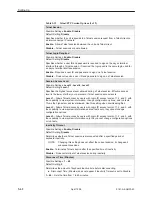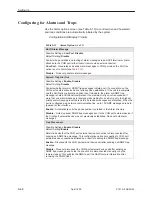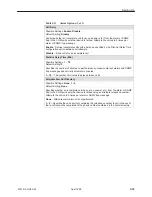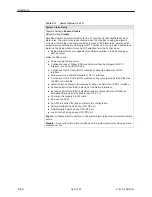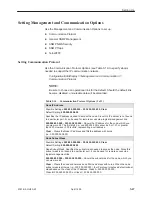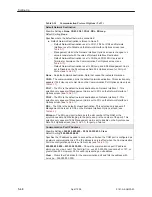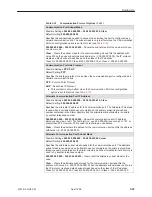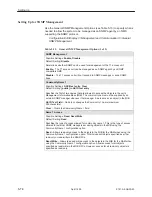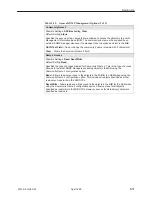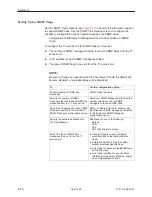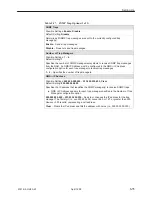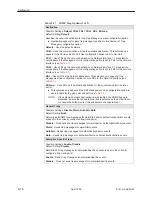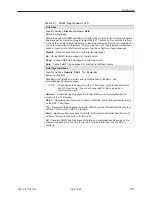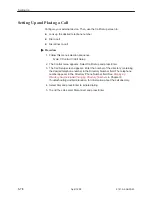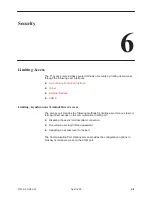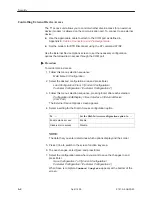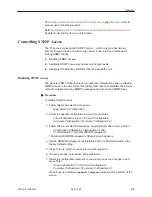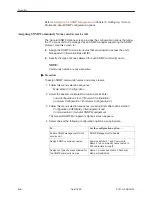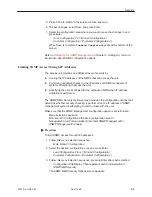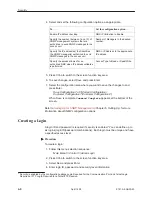
Setting Up
5-76
9161-A2-GH30-40
April 1999
Table 5-17.
SNMP Trap Options (2 of 3)
Destination
Possible Settings: Default, COM
, FDL1, FDL2, DDL, EDLss-p
Default Setting: Default
Specifies the network destination for the Trap Manager number configuration option.
Destination appears for each trap manager specified in the Number of Trap
Managers configuration option.
Default – Uses the default network.
COM – Uses the communication port as the network destination. This selection only
appears if the Communication Port Use configuration option is set to Net Link.
FDL1 – Uses FDL as the network destination on Network Interface 1. This selection
only appears if the Management Link configuration option is set to FDL for the network
interface (see
Table 5-1
).
FDL2 – Uses FDL as the network destination on Network Interface 2. This selection
only appears if the Management Link configuration option is set to FDL for the network
interface (see
Table 5-1
).
DDL – Uses DDL as the network destination. This selection only appears if the
management link configuration option is set to DDL for the Network interface (see
Table 5-1
).
EDL
ss-p – Uses EDL as the network destination for the synchronous port in slot ss,
port
p.
This selection only appears if the EDL Management Link configuration option is
set to Enable for the given slot and port (see
Table 5-3
).
NOTE:
If the selected network destination link is disabled, the SNMP traps are
discarded. Ensure that an operational link is selected as the default route,
or change the default route if the link becomes nonoperational.
General Traps
Possible Settings: Disable, Warm, AuthFail, Both
Default Setting: Both
Determines if SNMP trap messages for warmStart and/or authenticationFailure events
are sent to the currently configured trap manager(s).
Disable – Does not send trap messages for warmStart or AuthenticationFailure events.
Warm – Sends trap messages for warmStart events.
AuthFail – Sends trap messages for authenticationFailure events.
Both – Sends trap messages for both warmStart and AuthenticationFailure events.
Enterprise Specific Traps
Possible Settings: Enable, Disable
Default Setting: Disable
Determines if trap messages for enterpriseSpecific events are sent to the currently
configured trap manager(s).
Enable – Sends trap messages for enterpriseSpecific events.
Disable – Does not send trap messages for enterpriseSpecific events.
Summary of Contents for 9161 Single T1
Page 1: ...MODEL 916x 926x T1 ACCESS MUX TECHNICAL REFERENCE Document No 9161 A2 GH30 40 April 1999...
Page 34: ...Management and Control 2 6 9161 A2 GH30 40 April 1999 This page intentionally left blank...
Page 54: ...User Interface 4 10 9161 A2 GH30 40 April 1999 This page intentionally left blank...
Page 92: ...Setting Up 5 38 9161 A2 GH30 40 April 1999 Example Channel Allocation...
Page 142: ...Security 6 10 9161 A2 GH30 40 April 1999 This page intentionally left blank...
Page 252: ...IP Addressing B 8 9161 A2 GH30 40 April 1999 This page intentionally left blank...

